Arkansas’ 2022 season took a sudden downturn in an 88-66 drilling by Oklahoma in Tulsa last year. Now, the Hogs are seeking revenge, needing a win to keep the dream of a truly special season alive.
The Hogs now have an added challenge: replacing Trevon Brazile, lost for the season after tearing his ACL against UNC Greensboro. We discussed how the Hogs might replace him on Wednesday. Arkansas will have to find answers quickly, as a strong performance will be required to topple the Sooners.
Meet the Sooners
Porter Moser has coached a lot of basketball. He turned a successful run as Little Rock’s head coach (54-34 from 2000 to 2003) into the head coaching job at Illinois State, which ended with him being fired with a 51-67 record. After a few seasons as an assistant under legendary head coach Rick Majerus at Saint Louis, Moser began his comeback as head coach of Loyola Chicago. The rebuild took time, but in 2018, Moser’s seventh season, the Ramblers went 32-6 and made a run to Final Four, ending Eric Musselman and Nevada’s season in the Sweet Sixteen. Over Moser’s last four seasons, the Ramblers went 99-36 and even made another Sweet Sixteen. He turned that into the head coaching job at Oklahoma. The Sooners went 19-16 and ended up in the NIT in his first season last year.
Moser is, in many ways, the most faithful and most successful member of the Majerus coaching tree. His Sooners will look a lot like those old Utah teams. It’s not pretty to watch, but it is certainly effective.

Projected as an NCAA Tournament team, Oklahoma has been up and down to start the year. The Sooners were stunned by Sam Houston in their opener. They reeled off six straight – including a win over Ole Miss, expected to be a middle-of-the-pack SEC team – before falling to a struggling Villanova team that got its best player back for that game.

Model pick: Arkansas 68, Oklahoma 62.
When Oklahoma has the ball

Like any Majerus-influenced team, the Sooners want to play very, very slow on offense. Everything is deliberate. They hate chaos. Fast breaks? Chaotic. Oklahoma will go slow and do everything with purpose. Offensive rebounds? Chaotic. The Sooners mostly don’t even try for offensive boards. Turnovers? Chaotic. Oklahoma doesn’t turn it over very often. Drawing fouls? Chaotic. The Sooners prefer smooth halfcourt sets with good ball movement leading to a wide-open shot.
Oklahoma will use a lot of 5-out offense. That basically means all five players on offense are perimeter players. They still have big men – namely 6’10 center Tanner Groves, who throttled the Hogs last year – but their bigs don’t live in the post. They ask them to help pass and screen to initiate the offense.
The Sooner lineup is top-heavy, with Groves and 6’2 point guard Grant Sherfield dominating the touches. The Nevada transfer is off to a blazing hot start from beyond the arc. He also protects the ball and gets to the line, making him easily the best Sooner guard. When Groves comes out, 6’10 backup center Sam Godwin is used similarly. Outside of the main guys, you have Tanner’s brother Jacob Groves, who is a little smaller at 6’9 but a dangerous 3-point shooter. Then there’s 6’6 small forward Jalen Hill, an average shooter but pretty good defender. The shooting guard spot has been a mess, with 6’2 starter CJ Noland having a Desi Sills career arc: good on limited usage as a freshman, now can’t hit the broad side of a barn as a sophomore. Noland has started losing minutes, mostly to 6’3 Bijan Cortes, a turnover-prone but efficient shooter with long flowing hair, and 6’4 freshman Milos Uzan, a low-usage but effective scorer who also struggles with turnovers. So the trees for Oklahoma are tall, but the primary guards are both 6’2.
Here’s a pretty common early look, a high stack ball screen, with Sherfield initiating:
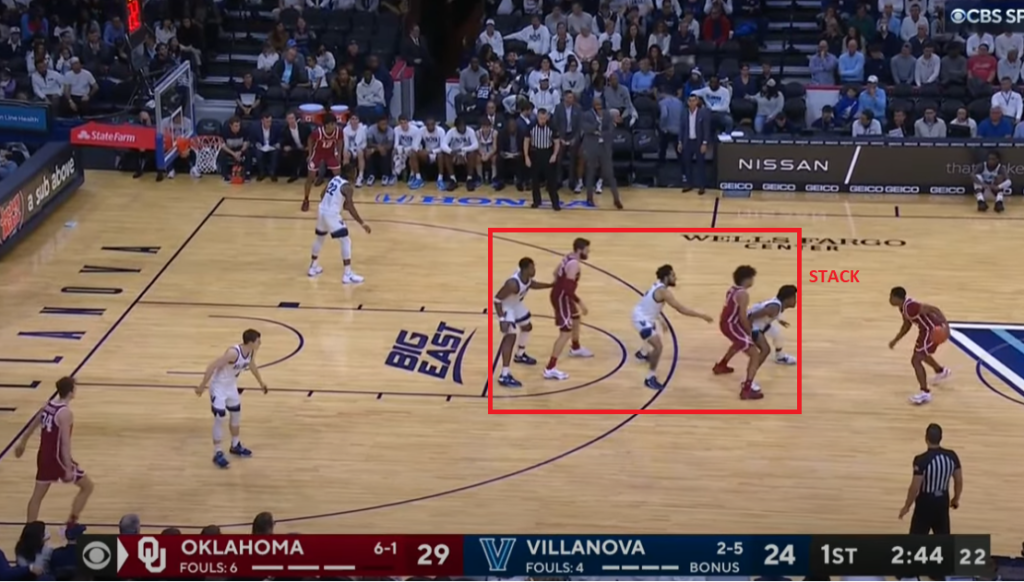
Nobody’s in the post here, so if that high ball screen creates a path to the rim, it’s going to be a race back for the defense to prevent an easy layup.
In this particular play, that doesn’t materialize, so the Sooners quickly break into their set play, which includes their center making a nice deep entry pass that draws a foul:
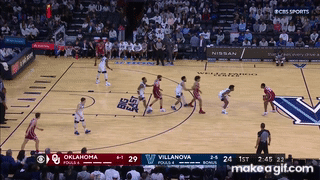
The nature of Oklahoma’s well-spaced motion offense leads to a lot of shots at the rim. In another example, Groves sets a high ball screen and receives a post entry immediately after:
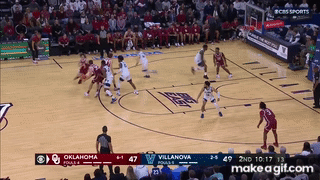
It’s very difficult to prevent this shot from happening. And this will be Arkansas’ biggest problem with this matchup.

Arkansas’ defensive philosophy this year is all about forcing tough two-point shots. It starts with not allowing many shots of any kind: the Hogs rank 11th in Effective Possession Ratio, which is the ratio of scoring chances to possessions. The Hogs force turnovers (21st) and clear defensive boards (34th), so opponents don’t get many shots at all. But when they do shoot, the Hogs force a decent rate of midrange jumpers and don’t allow many 3-point attempts.
The tradeoff, however, is that opponents are getting chances to score near the rim. Those chances are usually well-defended, which is why Arkansas’ actual FG% allowed at the rim is solid (63rd), but opponents are getting them nonetheless. This is a more traditional way to do man-to-man. It’s what you see in the NBA: smother the perimeter and force contested shots inside the arc.
It’s also a departure from last season, when Arkansas aimed to prevent shots near the rim from occurring at all. Last year’s team wasn’t very tall and lacked a true rim protector, so the Hogs knew they couldn’t defend around the rim straight-up. Instead, they focused on help defense under the basket and were willing to live with opponents who could create open 3-pointers off kickouts:
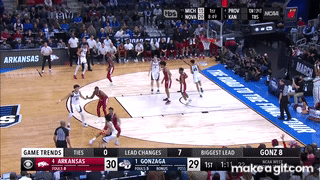
In this case, Notae leaving his man to help under the basket prevented a shot at the rim… but gave up a wide-open 3 in exchange. That’s how last year’s team operated. But with a taller team made up of more skilled individual defenders, the Hogs can help less, allowing them to give up fewer open 3-pointers but requiring them to defend better at the rim.
Here, Makhi gives a good example of what this team can do, defending in the post without help:
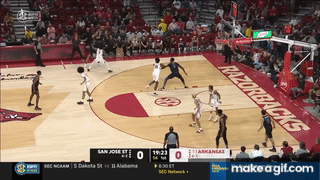
This is what the Mitchell twins were recruited to do. The Hogs had to scramble to prevent that shot last season, but that occasionally led to kickouts and open 3-pointers. This year, they’re more content to give Makhi a chance to defend.
On that play, you can see Council thinks about “digging”, which is where a perimeter off-ball defender tries to strip the ball from a posted-up offensive player without leaving his own man. He doesn’t do it, though. That’s a theme I’ve noticed so far this year: many times, Hog defenders are so focused on not over-helping that they end up not helping at all when they have a chance.
In this example, Brazile probably could have helped Makhi out by digging, but again he doesn’t do it, and the circus shot drops despite good defense:
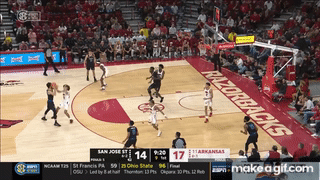
Oklahoma is going to test Arkansas’ ability to hold up in these 1-on-1 situations like no team so far. The Razorbacks crumbled last year, but this is a different team.
Ultimately, there’s zero doubt that Oklahoma will get chances at the rim. But the Sooners’ offensive success will come down to finishing. This is the second (Creighton) of what will probably be several tests of Arkansas’ “no post help” defense’s ability to hold up against a legitimate post presence. Any potential Final Four run will depend on it being better than last year.
When Arkansas has the ball

Oklahoma’s defense has a lot of similarities to Arkansas in terms of philosophy. Both defenses are man-to-man with the objective of smothering the perimeter and forcing tough two-point shots. But the main difference is while Arkansas pressures the ball, Oklahoma will pressure away from the ball. The Razorback ball pressure forces turnovers and speeds up opponents, at the expense of fouls. Oklahoma’s off-ball pressure does the opposite: the Sooners don’t force many turnovers, but they rarely foul, and they force opponents into very long possessions by denying passes and screens.
Denying screens
Oklahoma will try to take away the high ball screen that is the basis of Arkansas’ offense (and many other offenses). Watch the on-ball defender step in front to deny the screen, while the screener’s man steps into the screen to prevent the ball from going the other way:

See how Villanova has to reverse the ball and try again. That’s why Oklahoma defensive possessions are so long.
Stunts
If the Sooners can’t deny the screen, they’ll try to prevent the progression of play by “stunting”, where an off-ball defender steps into the path of the ball to stop it. Stunts like this force the offensive to hold up and rethink. Here, the Sooners can’t deny the handoff (and don’t want to switch Groves onto a guard) so they use a stunt to stop the zoom action off the handoff:
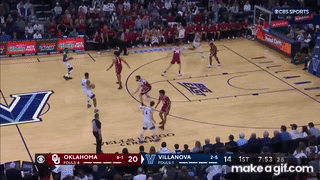
A few minutes after that, Villanova tries the same sequence, but the ballhandler tries to avoid the stunt by cutting more sharply inside. Recognizing the tighter cut, the Sooners simply switch and Godwin uses his height to block the shot:

The Sooners do all this without fouling and without coming off 3-point shooters. You just don’t get many easy looks. The Hogs will have to consistently get to the rim and finish there, but it’s very hard to just dribble your way into the paint because of Oklahoma’s deny-first defense.

The Hogs will get opportunities at the rim, but they will be tough. The Razorbacks have been elite at finishing all season, but this is the toughest test of that so far. It will be hard to rely on free throws or offensive rebounds to supplement, so those shots have to go in at a good rate.
So why does Oklahoma actually allow so many rim attempts, given the defense we saw in the above gif? After all, Villanova ended up getting a decent 41% of shots at the rim and made an excellent 70% of them.
Here are a couple of options.
Put Groves in ball screens
The Wildcats’ strategy was probably exactly what Arkansas will do. Villanova wanted to bring Groves to the top of the key and test out his ball screen defense.
One way is a slip screen. Knowing how the Sooners attack screens (deny on-ball and have the screener’s man step into the screen), Villanova tried a “slip” screen early in the game, where their center starts to set a screen and then breaks to the basket, counting on Groves’ aggressiveness to take him out of the play:
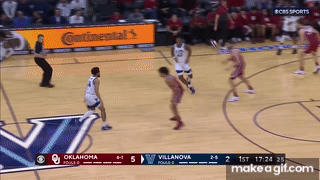
This was a good recovery by the Sooner defense, but #43 has to make that catch and he has a dunk.
Even late in the game, Villanova kept finding ways to attack Groves in ball screens. Here’s the setup for a key play late:
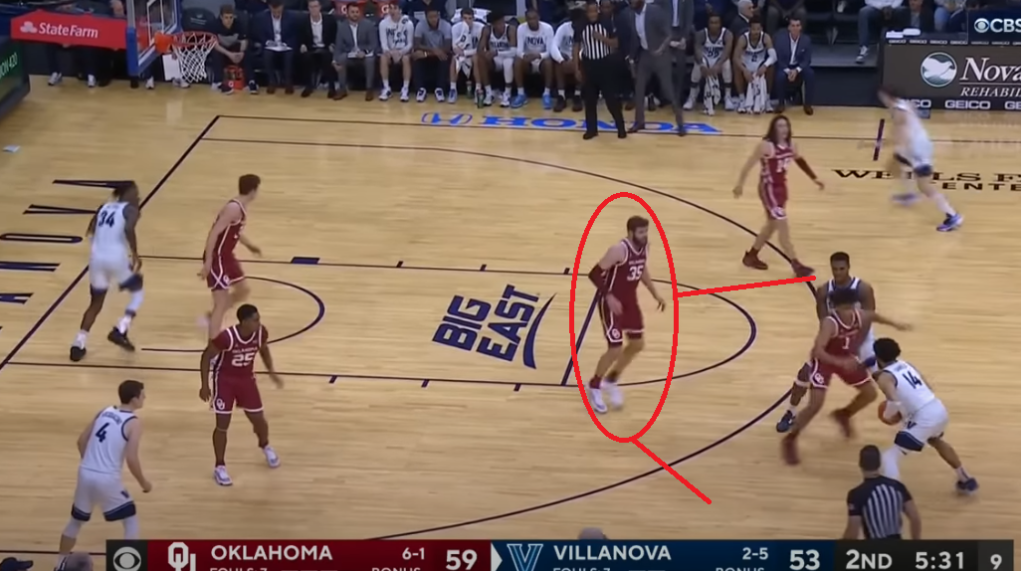
That’s Groves that I’ve circled. His man is setting a screen, and in typical Sooner fashion, the on-ball defender is denying it. But Villanova wasn’t intending to use the screen. Instead, the point guard moves away from the denied screen to his left. Groves has to step to the right to block the ball, but takes him away from his man (the screener), who peels off and gets an open path to the basket:
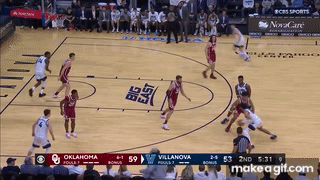
Unfortunately, plays like that are where Arkansas will miss Brazile.
Isolations
Ultimately, the Sooner defense is vulnerable in the same way Arkansas is: they don’t help much inside the arc. They guard against dump-off passes and kickouts – never leaving corner shooters was one of Majerus’s big coaching points – but the tradeoff is that they expect their guys to hold up in 1-on-1 situations.
So when the Wildcats were able to get 5-star phenom Cam Whitmore in a 1-on-1 with Jacob Groves, they were happy to take it:
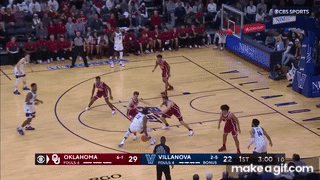
In the second half, Villanova started doing a lot of these one-side isolations:
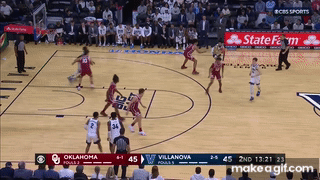
Godwin (#10) does offer some late help, but the Villanova guard already had a step.
A couple possessions later, the Wildcats do it again, this time with a guard backing down his man:
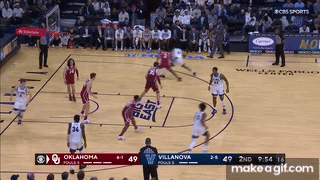
Again, note the lack of help outside of a quick dig by Groves. Nick Smith will be Arkansas’ best option on these isos, but both Ricky Council and Anthony Black can win them as well. An iso isn’t a super-efficient play unless you have a mismatch, but Arkansas is talented enough to create mismatches without even switching.
Let’s summarize how to beat this difficult defense:
- Turn their aggressiveness against them. In the above sequence, Villanova was able to use Oklahoma’s ball screen denial against them to create an open path to the rim. “Traditional” pick-and-rolls don’t work well against a defense like this, instead, you have to react to way they are reacting.
- Go straight to the rim. Offenses that play tentative don’t do well against Oklahoma. That’s largely what happened to the Hogs on offense last year. You have to be decisive in your attack and finish strong. Extra passes don’t work (notice in the above gif how neither Sooner defender leaves his man in the corner) and will probably just be intercepted. The Sooners will force you to make tough twos, but they’ll have no answers if you can.
Personnel

Quick comparison using Adjusted Box Plus Minus (aBPM), the basis of our grades.
Oklahoma starting lineup:
- Tanner Groves +8.8
- Jacob Groves +3.8
- Jalen Hill +0.6
- CJ Noland -5.1
- Grant Sherfield +7.5
- Total +15.6 – this lineup would outscore a perfectly average team by 15.6 points per 100 possessions
Arkansas starting lineup:
- Makhi Mitchell +8.7
- Jordan Walsh +2.5
- Ricky Council +6.6
- Nick Smith +6.9
- Anthony Black +6.8
- Total +31.5
So the Hogs’ starters are about 15.9 points per 100 possessions better than Oklahoma’s. In a 70-possession game, that equates to an 11-point gap. But the Sooners’ top three reserves have a combined aBPM of +14.8, while Arkansas’ top three reserves (Devo Davis, Kamani Johnson, Jalen Graham) total just +4.4. With the Hogs’ sixth man gone for the year, Arkansas’ bench is going to need to step up, because the Sooners suffer very little dropoff when their starters need a breather.
Keys to the Game
- Defend in the post. The Hogs got bombed on from 3-point land in last year’s meeting. This year’s team will smother the perimeter, but defensive success depends on surviving 1-on-1 encounters in the post. If the Sooners are able to get those shots to drop, this could be a rough game.
- Finish at the rim. The opposite is key for the Arkansas offense: while the Hogs need to prevent Oklahoma from finishing its paint shots, Arkansas has to finish its own. The winner will probably be the team that shoots a better percentage at the rim.
- Find one more guy. Arkansas’ starting five is elite, but the Hogs already had a short bench before Trevon Brazile was lost for the year. Talent-wise, this is the deepest Arkansas team in more than two decades, but is there someone who hasn’t played much who’s ready to step up and give some key minutes?
Thanks for reading! Be sure to follow us on Twitter.
The latest from Fayette Villains, straight to your inbox
Enter your email to subscribe and receive new post alerts and other updates. You can unsubscribe at any time.